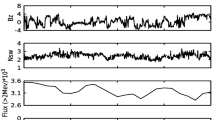Abstract
The global characteristics of the ionospheric storm and irregularities as well as propagation of TEC (total electron content) disturbances during the strong magnetic storm occurring in November 2004 were investigated by using the data of the IGS network. For the response of the global ionospheric TEC to this strong magnetic storm, the following features are noticeable: 1) the maximum of the ionospheric storm phase occurred around the main phase maximum of the magnetic storm; 2) the TEC response in equatorial and low latitudes was more remarkable than that in mid-high latitudes; 3) as a whole, the storm phase in the northern hemisphere was mainly positive, and it was negative in the southern hemisphere; 4) during the whole magnetic storm from November 7 to 11, the locations where the maxima of the positive and negative ionospheric storm phases occurred were nearly invariant to the Sun at low and equatorial latitudes, i.e. the 24-h recurrence. Analyzing results of TEC rate and its standard deviation showed that the ionospheric irregularities and disturbances in the global mainly occurred around the main phase maximum of the storm, and they distributed in a large longitudinal region for both day and night in mid-high latitudes and they generated and developed only after the sunset, and lasted out to the midnight in equatorial and low latitudes. The disturbance propagation parameters were also estimated by using the wavelet reconstruction and cross-correlation technologies for a set of spaced stations in the Northern America.
Similar content being viewed by others
References
Schunk R W, Sojka J J. Ionosphere-thermosphere space weather issues. J Atmos Terr Phys, 1996, 58(14): 1527–1574
Buonsanto M J. Ionospheric storms-a review. Space Sci Rev, 1999, 88: 563–601
Abdu M A. Major phenomena of the equatorial ionosphere-thermosphere system under disturbed conditions. J Atmos Solar-Terr Phys, 1997, 59(13): 1505–1519
Schunk R W. Response of the ionosphere-thermosphere system to magnetospheric forcing. Adv Space Res, 1990, 10(6): 133–142
Prolss G W, Brace L H, Mayr H G, et al. Ionospheric storm effects at subauroral latitudes: A case study. J Geophys Res, 1991, 96(2): 1275–1288
Ho C M, Mannucci A J, Lindqwister U J, et al. Global ionospheric perturbations monitored by the worldwide GPS network. Geophys Res Lett, 1996, 23(20): 3219–3222
Pi X, Manucci A J, Lindqwister U J, et al. Monitoring of global ionospheric irregularities using the wor1dwide GPS network. Geophys Res Lett, 1997, 24(18): 2283–2286
Tsagouri I, Belehaki A, Moraitis G, et al. Positive and negative ionospheric disturbances at middle latitudes during geo magnetic storms. Geophys Res Lett, 2000, 27(21): 3579–3582
Zhang D H, Xiao Z. A method of calculating TEC with GPS data and its application to the ionospheric disturbances. Chin J Geophys, 2000, 43(4): 451–459
Mannucci A J, Wilson B D, Yuan D N, et al. A global mapping technique for GPS-derived ionospheric total electron content measurements. Radio Sci, 1998, 33(3): 565–582
Li Q, Zhang D H, Qin J S, et al. Analysis of global ionospheric TEC disturbance during the magnetic storm in Nov. 2004. Chin J Space Sci, 2006, 26(6): 440–444
Maruyama T. Extreme enhancement in total electron content after sunset on 8 November 2004 and its connection with storm enhanced density. Geophys Res Lett, 2006, 33, L20111, doi:10.1029/ 2006GL027367
Pirog O M, Polekh N M, Voeykov S V, et al. Ionospheric disturbances in the East-Asian region during geomagnetic storm in November. Adv Space Res, 2004, 39(8): 1335–1341
Fedrizzi M, de Paula E R, Langley R B, et al. Study of the March 31, 2001 magnetic storm effects on the ionosphere using GPS data. Adv Space Res, 2005, 36: 534–545
Ma S Y, Xu L, Yeh K C. A study of ionospheric electron density deviation during two great storms. J Atmos Terr Phys, 1995, 57(9): 1037–1043
Aarons J, Mendillo M, Yantosca R. GPS phase fluctuations in the equatorial region during the MISETA l994 campaign. J Geophys Res, 1996, l0l(A12): 26851–26862
Basu S, Groves K M, Quinn J M, et al. A comparison of TEC fluctuations and scintillations at Ascension Island. J Atmos Solar-Terr Phys, 1999, 61(16): 1219–1226
Xu J S, Zhu J, Cheng G H. GPS observations of ionospheric effects of the major storm of Nov. 7–10, 2004. Chin J Geophys, 2006, 49(4): 950–956
Basu S, Basu S, Chaturvedi P K, et al. Irregularity structures in the cusp cle1t and polar cap regions. Radio Sci, 1994, 29(1): 195–208
Kersley L, Russsel C D, Rice D L. Phase scintil1ation and irregularities in the northern polar ionosphere. Radio Sci, 1995, 30(3): 619–630
Pryse S E, Kersley L, Walker I K. Blobs and irregu1arities in the auroral ionosphere. J Atmos Terr Phys, 1996, 58(1): 205–215
Kil H, Kintner P M. Global Positioning System measurements of the ionospheric zonal apparent velocity at Cachoeira Paulista in Brazil. J Geophys Res, 2000, 105(A3): 5317–5327
Lu F, Xu J S, Zou Y H. An analysis of observation of ionospheric storms and TIDs using a GPS-array. J Wuhan Univ (Natural Science Edition), 2004, 50(3): 365–369
Abdu M A. Equatorial ionosphere-thermosphere system: Electrodynamics and irregularities. Adv Space Res, 2005, 35: 771–787
Author information
Authors and Affiliations
Corresponding author
Additional information
Supported by the National Natural Science Foundation of China (Grant Nos. 40474055, 40504019)
Rights and permissions
About this article
Cite this article
Xu, L., Cheng, G., Xu, J. et al. Global ionospheric TEC response to a strong magnetic storm. Sci. China Ser. E-Technol. Sci. 51, 1786–1802 (2008). https://doi.org/10.1007/s11431-008-0270-y
Received:
Accepted:
Published:
Issue Date:
DOI: https://doi.org/10.1007/s11431-008-0270-y




